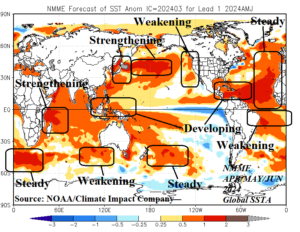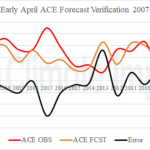Executive summary: During the past decade marine heat waves (MHW) have dramatically increased their presence, aerial coverage, and duration poleward of the deep tropics in both hemispheres. The influence on climate is dramatic and warrants application of a 10-year optimum climate normal (OCN) both to generating seasonal forecasts and explaining climate regime observations on an annual, seasonal, and monthly basis. In February 2024, MHW’s occupied 38% of the global oceans ranking 5th during all months since 1991 according to NOAA.
Of concern, are MHW’s in the tropical/subtropical North Atlantic forecast to strengthen dramatically increasing the risk of stronger hurricanes due to the plentiful upper ocean heat. Record warm SSTA is possible based on the NMME global SSTA forecasts.
Entering a second year is a strong MHW in the eastern North Atlantic basin forecast to strengthen. Upper-level high pressure ridge risk downwind of the MHW has increased risk warranting hot and dry concerns for summertime in Europe.
Interestingly, a semi-permanent Northeast Pacific MHW is not forecast to return this year (despite the NMME forecast) with strong warm SSTA intensity staying westward near Japan to the Dateline. Increased risk of stronger than normal subtropical ridging to produce unusual heat across East China and Japan is likely.
Additionally, the Indonesia/West Pacific tropical waters are forecast to develop strong MHW conditions. The far West Pacific tropics/subtropics are likely to observe above normal typhoons. Southeast Asia drought should reverse. MHW influence on the Indian Monsoon is not well-understood.
MHW’s south of Africa and Australia and in the vicinity of New Zealand are steady or weaken slightly in 2024. The lack of MHW’s either side of the mid-latitude coastline of South America suggest increased risk of a winter upper-level trough and attendant cold weather risk possibly reaching Brazil.

Fig. 1: The NMME APR/MAY/JUN 2024 global SSTA forecast and marine heat waves identified by NOAA and Climate Impact Company.

Fig. 2: The NMME AUG/SEP/OCT 2024 global SSTA forecast and marine heat waves identified by NOAA and Climate Impact Company.



